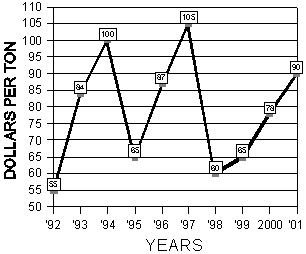Alfalfa Report
Yuma County, Arizona
September 24, 2001
Yuma County Office
2200 W. 28th Street, Ste. 102
Yuma, AZ 85364
(928) 726-3904
(928) 726-8472 FAX
Production Update:
PDF version, 40KB
Planting Date: October is the optimum planting date for low desert areas in Arizona, although it is possible to plant alfalfa from September through March. Crop establishment is best in October plantings. Planting too early can result in poor crop establishment due to hot weather, losses from competition from summer weeds, or damage from feeding from whitefly. Winter plantings are at risk for freeze damage, and seedlings with one trifoliate leaf stand a better chance of surviving freeze damage than younger seedlings. Hay production during the first spring is missed in spring plantings and production is delayed until the first summer. Spring plantings tend to be subject to more weed competition and result in a less developed root system compared to fall planting during the establishment year. Delaying planting past October can decrease yields for the life of the stand.
Insect Management: Three-cornered alfalfa hoppers are found in alfalfa from spring into the fall. They feed by inserting their needle-like mouth parts into stems and sucking out juices. Adult female hoppers girdle stems by depositing eggs causing the stem and leaves to turn red, purple or yellow above the girdle. Adults are light-green, thick-bodied, triangular insects about one-fourth inch long which move about the plants and fly when disturbed. Nymphs are grayish-white, soft-bodied, with saw-toothed spines on their backs and are confined to the lower portions of the plant. Nymphs may not be picked up in a sweep net. There are rarely enough three-cornered alfalfa hoppers in alfalfa fields to cause economic damage. An economic threshold has not been established, but if there are fewer than 15 three-cornered hoppers per sweep, it may not be economical to treat with insecticides.
Weed Control: October is not too early to make preemergent herbicide
applications for the control of winter annual weeds. Annual bluegrass,
for instance, can be controlled with an October application of trifluralin
granules but it is difficult to control this weed once it becomes established.
| Market Summary |
High
|
Low
|
Average
|
Off grade
|
| Past 2 Weeks (Sept. 10 to Sept. 23, 2001) |
95
|
85
|
90
|
70-80
|
| Last Year (Sept. 10 to Sept. 23, 2000) |
80
|
75
|
78
|
60-70
|
10 Year Summary (September 10, to September 23, 1992-2001):

Issued in furtherance of Cooperative Extension work, acts of May 8 and June 30, 1914, in cooperation with the U.S. Department of Agriculture, James A. Christenson, Director Cooperative Extension, College of Agriculture and Life Sciences, The University of Arizona.
The University of Arizona is an equal opportunity, affirmative action institution. The University does not discriminate on the basis of race, color, religion, sex, national origin, age, disability, veteran status, or sexual orientation in its programs and activities.
Any products, services, or organizations that are
mentioned, shown, or indirectly implied in this web document do not imply
endorsement by The University of Arizona.
Information provided by:
Barry Tickes, btickes@ag.arizona.edu Extension Agent, Yuma County
Michael Ottman, mottman@ag.arizona.edu Agronomy Specialist
College of Agriculture, The University of Arizona.
Eric Natwick, etnatwick@ucdavis.edu UCCE Imperial County - Farm Advisor
University of California, Davis, CA.
Material written September 24, 2001.
Forages: Crop Mgmt | Soil Mgmt | Irrigation | Alfalfa Reports | Insects | Diseases | Weeds | Pesticides
Home | Other Crops | Forages
For more Arizona Production Ag Information:
Home | Cotton | Veggies| Forages | Grains | Citrus | Crop x Crop | Insects | Diseases| Weeds | Pesticides | News | Weather | Research | Photos | Contacts | General Info. | Site Map
Copyright © 2001 University of Arizona,
College of Agriculture and Life Sciences
Webmaster: Al Fournier (fournier@ag.arizona.edu)